I have modified Line graph of Minh Nguyen to some extend to show two lines one for systolic and othere for diastolic.
The first image show the how the graph should look like and second image is what I have achieved.
struct PointEntry {
let systolic: Int
let diastolic: Int
let label: String
}
extension PointEntry: Comparable {
static func <(lhs: PointEntry, rhs: PointEntry) -> Bool {
return lhs.systolic < rhs.systolic || lhs.systolic < rhs.systolic
}
static func ==(lhs: PointEntry, rhs: PointEntry) -> Bool {
return lhs.systolic == rhs.systolic && lhs.diastolic == rhs.diastolic
}
}
class LineChart: UIView {
/// gap between each point
let lineGap: CGFloat = 30.0
/// preseved space at top of the chart
let topSpace: CGFloat = 20.0
/// preserved space at bottom of the chart to show labels along the Y axis
let bottomSpace: CGFloat = 40.0
/// The top most horizontal line in the chart will be 10% higher than the highest value in the chart
let topHorizontalLine: CGFloat = 110.0 / 100.0
/// Dot inner Radius
var innerRadius: CGFloat = 8
/// Dot outer Radius
var outerRadius: CGFloat = 12
var dataEntries: [PointEntry]? {
didSet {
self.setNeedsLayout()
}
}
/// Contains the main line which represents the data
private let dataLayer: CALayer = CALayer()
/// Contains dataLayer and gradientLayer
private let mainLayer: CALayer = CALayer()
/// Contains mainLayer and label for each data entry
private let scrollView: UIScrollView = {
let view = UIScrollView()
view.showsVerticalScrollIndicator = false
view.showsHorizontalScrollIndicator = false
return view
}()
/// Contains horizontal lines
private let gridLayer: CALayer = CALayer()
/// An array of CGPoint on dataLayer coordinate system that the main line will go through. These points will be calculated from dataEntries array
private var systolicDataPoint: [CGPoint]?
private var daistolicDataPoint: [CGPoint]?
override init(frame: CGRect) {
super.init(frame: frame)
setupView()
}
convenience init() {
self.init(frame: CGRect.zero)
setupView()
}
required init?(coder aDecoder: NSCoder) {
super.init(coder: aDecoder)
setupView()
}
private func setupView() {
mainLayer.addSublayer(dataLayer)
mainLayer.addSublayer(gridLayer)
scrollView.layer.addSublayer(mainLayer)
self.addSubview(scrollView)
}
override func layoutSubviews() {
scrollView.frame = CGRect(x: 0, y: 0, width: self.frame.size.width, height: self.frame.size.height)
if let dataEntries = dataEntries {
scrollView.contentSize = CGSize(width: CGFloat(dataEntries.count) * lineGap + 30, height: self.frame.size.height)
mainLayer.frame = CGRect(x: 0, y: 0, width: CGFloat(dataEntries.count) * lineGap + 30, height: self.frame.size.height)
dataLayer.frame = CGRect(x: 0, y: topSpace, width: mainLayer.frame.width, height: mainLayer.frame.height - topSpace - bottomSpace)
systolicGradientLayer.frame = dataLayer.frame
diastolicGradientLayer.frame = dataLayer.frame
systolicDataPoint = convertDataEntriesToPoints(entries: dataEntries, isSystolic: true)
daistolicDataPoint = convertDataEntriesToPoints(entries: dataEntries, isSystolic: false)
gridLayer.frame = CGRect(x: 0, y: topSpace, width: CGFloat(dataEntries.count) * lineGap + 30, height: mainLayer.frame.height - topSpace - bottomSpace)
clean()
drawHorizontalLines()
drawVerticleLine()
drawChart(for: systolicDataPoint, color: .blue)
drawChart(for: daistolicDataPoint, color: .green)
drawLables()
}
}
/// Convert an array of PointEntry to an array of CGPoint on dataLayer coordinate system
/// - Parameter entries: Arrays of PointEntry
private func convertDataEntriesToPoints(entries: [PointEntry], isSystolic: Bool) -> [CGPoint] {
var result: [CGPoint] = []
// let gridValues: [CGFloat] = [0.125, 0.25, 0.375, 0.5, 0.625, 0.75, 0.875, 1.0, 1.05]
for (index, value) in entries.enumerated() {
let difference: CGFloat = 0.125 / 30
let userValue: CGFloat = isSystolic ? CGFloat(value.systolic) : CGFloat(value.diastolic)
var height = (userValue - 30.0) * difference
height = (1.0 - height) * gridLayer.frame.size.height
let point = CGPoint(x: CGFloat(index)*lineGap + 40, y: height)
result.append(point)
}
return result
}
/// Draw a zigzag line connecting all points in dataPoints
private func drawChart(for points: [CGPoint]?, color: UIColor) {
if let dataPoints = points, dataPoints.count > 0 {
guard let path = createPath(for: points) else { return }
let lineLayer = CAShapeLayer()
lineLayer.path = path.cgPath
lineLayer.strokeColor = color.cgColor
lineLayer.fillColor = UIColor.clear.cgColor
dataLayer.addSublayer(lineLayer)
}
}
/// Create a zigzag bezier path that connects all points in dataPoints
private func createPath(for points: [CGPoint]?) -> UIBezierPath? {
guard let dataPoints = points, dataPoints.count > 0 else {
return nil
}
let path = UIBezierPath()
path.move(to: dataPoints[0])
for i in 1..<dataPoints.count {
path.addLine(to: dataPoints[i])
}
return path
}
/// Create titles at the bottom for all entries showed in the chart
private func drawLables() {
if let dataEntries = dataEntries,
dataEntries.count > 0 {
for i in 0..<dataEntries.count {
let textLayer = CATextLayer()
textLayer.frame = CGRect(x: lineGap*CGFloat(i) - lineGap/2 + 40, y: mainLayer.frame.size.height - bottomSpace/2 - 8, width: lineGap, height: 16)
textLayer.foregroundColor = UIColor.black.cgColor
textLayer.backgroundColor = UIColor.clear.cgColor
textLayer.alignmentMode = CATextLayerAlignmentMode.center
textLayer.contentsScale = UIScreen.main.scale
textLayer.font = CTFontCreateWithName(UIFont.systemFont(ofSize: 0).fontName as CFString, 0, nil)
textLayer.fontSize = 11
textLayer.string = dataEntries[i].label
mainLayer.addSublayer(textLayer)
}
}
}
/// Create horizontal lines (grid lines) and show the value of each line
private func drawHorizontalLines() {
let gridValues: [CGFloat] = [1.05, 1.0, 0.875, 0.75, 0.625, 0.5, 0.375, 0.25, 0.125]
let gridText = ["", "30", "60", "90", "120", "150", "180", "210", "240"]
for (index, value) in gridValues.enumerated() {
let height = value * gridLayer.frame.size.height
let path = UIBezierPath()
if value == gridValues.first! {
path.move(to: CGPoint(x: 30, y: height))
} else {
path.move(to: CGPoint(x: 28, y: height))
}
path.addLine(to: CGPoint(x: gridLayer.frame.size.width, y: height))
let lineLayer = CAShapeLayer()
lineLayer.path = path.cgPath
lineLayer.fillColor = UIColor.clear.cgColor
lineLayer.strokeColor = UIColor.black.cgColor
if value != gridValues.first! {
lineLayer.lineDashPattern = [4, 4]
}
lineLayer.lineWidth = 0.5
gridLayer.addSublayer(lineLayer)
let textLayer = CATextLayer()
textLayer.frame = CGRect(x: 4, y: height-8, width: 50, height: 16)
textLayer.foregroundColor = UIColor.black.cgColor
textLayer.backgroundColor = UIColor.clear.cgColor
textLayer.contentsScale = UIScreen.main.scale
textLayer.font = CTFontCreateWithName(UIFont.systemFont(ofSize: 0).fontName as CFString, 0, nil)
textLayer.fontSize = 12
textLayer.string = gridText[index]
gridLayer.addSublayer(textLayer)
}
}
private func drawVerticleLine() {
let height = gridLayer.frame.size.height * 1.05
let path = UIBezierPath()
path.move(to: CGPoint(x: 30, y: 0))
path.addLine(to: CGPoint(x: 30, y: height))
let lineLayer = CAShapeLayer()
lineLayer.path = path.cgPath
lineLayer.fillColor = UIColor.clear.cgColor
lineLayer.strokeColor = UIColor.black.cgColor
lineLayer.lineWidth = 0.5
gridLayer.addSublayer(lineLayer)
}
private func clean() {
mainLayer.sublayers?.forEach({
if $0 is CATextLayer {
$0.removeFromSuperlayer()
}
})
dataLayer.sublayers?.forEach({$0.removeFromSuperlayer()})
gridLayer.sublayers?.forEach({$0.removeFromSuperlayer()})
}
}
How can I add shadow to lines like shown in the first image and add simple line drawing animation to the Graph?

